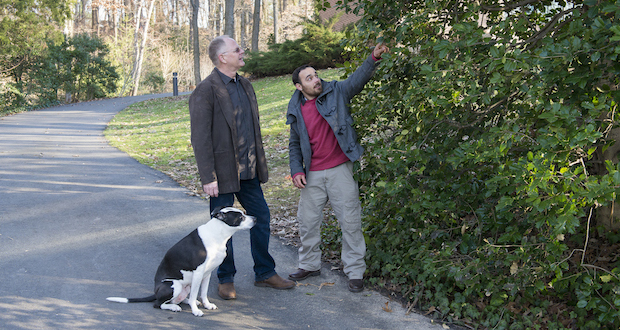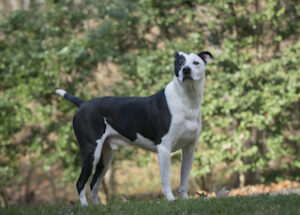A New Breed of Hero
OPEI’s TurfMutt program highlights the importance of living landscapes, and you can help.
By John Kmitta and Steve Noe

“We don’t want the California water problem to become a national problem,” said Kris Kiser, president and CEO of the Outdoor Power Equipment Institute (OPEI). According to Kiser, homeowners need to be made aware that they don’t have to rip out their grass and replace it with artificial turf or rocks. Instead, it is about understanding and identifying the right species for the location. It’s not that you can’t have grass, they’re just telling you not to water, he added.
This is just one of the messages regarding living landscapes that Kiser and his rescue dog, Lucky, are trying to convey. As Kiser would tell you, they are trying to “paw” it forward.
Lucky, otherwise know as “TurfMutt,” serves as the “spokesdog” for the OPEI Education & Research Foundation’s TurfMutt environmental stewardship and education program by Scholastic, for children in grades K-5. The national program has reached more than 62 million children, educators and families since 2009, showing them how they can “save the planet, one yard at a time.”
The TurfMutt program includes lesson plans for teachers, take-home sheets and learning activities for families, a website and blog, interactive games and a digital storybook.
Through the TurfMutt program, children learn how a green space benefits their community (see infographic on page 14). Backyard science activities explore how grass keeps water and air clean and the planet cooler, how plants make rivers and lakes healthier, and how grass helps to prevent water pollution.
“Green space matters. It matters to our communities and our families,” said Kiser. “It’s not just about teaching children science and environmental education. It’s about getting outside, and taking care of green space, and being part of a community that cares, and together making a difference.”
Kiser and TurfMutt have taken those messages to network television as well, and they are appearing this season on the Emmy Award-winning “Lucky Dog” television show that airs Saturday mornings on CBS as a part of the “CBS Dream Team, It’s Epic” block of programming.
The “Lucky Dog” show follows animal trainer Brandon McMillan, who rescues and trains untrained and unadoptable dogs. In the end, a lucky family adopts an even luckier dog. As part of the program, Kiser and TurfMutt help educate the adopting family, and viewers, on ways to create environmentally responsible living landscapes that families and pets can enjoy.
“I met many families living in California as part of taping the show, and was able to visit their yards and provide tips on how to make a living landscape a home for their new pups,” said Kiser. “It’s not just about having a lawn for your dog and your kids at all costs. It’s about having the right kind of yard, including a lawn, for the environment you are living in today.”
TurfMutt has been a success. In addition to being on national television, it is an educational resource with the U.S. Environmental Protection Agency (EPA), the U.S. Department of Interior, the U.S. Green Building Council, the U.S. Department of Education’s Green Ribbon Schools, the U.S. Department of Energy, Green Apple, the Center for Green Schools, the Outdoors Alliance for Kids, the National Energy Education Development (NEED) project, Climate Change Live, Petfinder, and the U.S. Fish and Wildlife Service.
Although the TurfMutt educational program has enjoyed success in reaching school-age children and their families, Kiser and OPEI would like to see TurfMutt’s message reach a much wider audience. A big part of that effort starts with the manufacturers, equipment dealers and contractors in the green industry.
Spread the message
“We’ve had very real support amongst the manufacturers in direct funding, association funding, and foundation-to-foundation funding,” said Kiser. “Several of them have just seen some of the latest TV work, and they’re really on board now. Now they get it, and it’s working, and so how now to build upon that? How do we engage dealers? How do we engage landscapers? How do we engage homeowners?”
According to Kiser, the goal is to expand the TurfMutt program and its message to engage landscape industry professionals and outdoor power equipment dealers to essentially change homeowners and the work they do, or have done, on a home site to become environmentally aware.
Kiser added that an environmentally friendly landscape does not have to be native. “It can be maintenance or a combination of adaptive and native,” he said. “But let’s not lose sight of the performance, the working of a yard, for the family, for the dog. What we don’t want to lose is the ability to enjoy the outdoors. Let’s maintain it in a way that the family can use it, and still provide the environmental benefit. We’re just trying to educate people that the outdoors begins at your back door. And so take those necessary steps.
“If we don’t do this. If we as an industry don’t step up, then EPA, California, or the Southern Nevada Water Authority will continue to permeate the population with ‘the lawn is bad.’
“In California, the governor essentially said, ‘The lawn’s gotta go, because of water,’” Kiser added. However, the consequences are severe. People replaced their lawns and managed landscapes with rocks, mulch and cacti. When rain did come, it caused a problem. “Anything that was removed is now a mud pit,” said Kiser. “Or the guy’s lawn up the hill is now in your lawn. So, there are consequences to that.”
Kiser added that he doesn’t want the lawn to be trendy to remove. “California sets these trends in fashion and cars and media and television,” he said. “The last thing we need is for California’s impression of a lawn — that it’s bad — to become a trend, or that it’s fashionable or trendy to tear out the lawn. That’s something that I think we just have to immediately address, and I think dealers in particular can help with that.
“The California government has already started to backtrack a little,” said Kiser. “They’re saying, ‘Oh, no, no, no. We didn’t say the lawn had to go. We just said we had to have x-percent water savings.’ They’re finding that they’re getting pretty much to their water-savings goals by not necessarily ripping up the lawns.”
Kiser pointed out that only 9 percent of California’s water use comes from landscape usage, according to the California Cooperative Extension Service. Even if every lawn in California was ripped out and no water was used for landscape care, the state would only lower its water usage by 9 percent.
Kiser said he could talk about the value of managed turf all day long, and chances are that people won’t listen. But TurfMutt resonates with people, and gets kids and adults alike to pay attention to the message being spread.
As a green industry professional, OPEI is hoping that TurfMutt gets your attention and resonates with you as well.
“Contractors, landscapers and dealers are on the front lines. They’re the people that talk to the customers,” said Kiser. “I really think they need to become better educators. If we don’t get smarter about this, we’re just gonna see our business continue to shrink and shrink and shrink.
“Heretofore, TurfMutt has been an education program at the elementary school level, and by default, to teachers; and then it evolved into teachers, families and kids,” Kiser added. “It has now moved beyond that.”
John Kmitta is associate publisher and editor of Landscape and Irrigation magazine. He can be reached via e-mail at jkmitta@epgmediallc.com. Steve Noe is editor of Outdoor Power Equipment magazine. He can be reached via e-mail at snoe@epgmediallc.com.
FACT SHEET: The Environmental Benefits of an Everyday Yard
Living landscapes with appropriate grasses, trees, shrubs and plants provide a host of environmental benefits.
HEAT: Turfgrass dissipates the heat island effect in urban areas.
AIR QUALITY: Turfgrass improves air quality.
CARBON: Turfgrass is the largest carbon sink in the country.
OXYGEN: Our lawns are incredible oxygen-making machines.
BIODIVERSITY: Turfgrass supports biodiversity and wildlife.
WATER RUN-OFF: Turfgrass assists in controlling water runoff and cleans rainwater before it goes into the ground.
SOIL EROSION: Turfgrass controls soil erosion.
FIRE BREAK: Turfgrass is a natural and effective fire break.
NOISE POLLUTION: Turfgrass helps control noise pollution.
PLAY SPACE: Turfgrass provides a safe place for children and pets to play.
Information provided by the Outdoor Power Equipment Institute.
For additional resources, visit opei.org/stewardship.
The Right Lawn
According to OPEI, even in a drought, you can have a lawn. It just needs to be the right lawn. The following are OPEI’s recommendations:
- Think long and hard before installing hardscape or artificial turf as a lawn replacement. These surfaces can heat up dramatically to the point of burning people and pets, and offer none of the oxygen-producing and pollutant-cleansing benefits of grass. And they still require water to clean them and remove pet waste.
- Plant the right turfgrass. Hundreds of varieties of turfgrass exist, and some of them are perfect for drought conditions. For example, buffalo grass, when established, requires very little water.
- Let it turn brown. In drought-challenged areas, we must get out of the mindset that all plants must stay green all the time. Grass will turn brown when it goes into dormancy. Turfgrass is incredibly resilient. It will spring back to green when rain comes back.
- Don’t overwater grass. Grass gets lazy if you water it too much. Make grass work hard for its water. If watered too much, grass sends its roots horizontally. With little water, grass will send its roots deeper, vertically, seeking water. As a result of having to work harder, it will do a better job of sequestering carbon and releasing oxygen.
- Water wisely. Only water your yard when it is necessary. Install watering solutions that help you use less water, but still permit you to have a living landscape. Install smart controllers on irrigation systems.
- Mix native plants with adaptive plants and grasses. We no longer live in a native environment. We live in cities and suburbs where we must incorporate plants into an area with a lot of concrete, asphalt, people and traffic. A mixture of both native plants and drought-resistant adaptive species can survive these conditions.
- Evolve your yard. Incorporate pollinator plants for bees, butterflies and hummingbirds. Even in the desert, a host of plants flower.
- Plant to slow and capture water. Water sheets off hard surfaces, asphalt and other hardscapes in cities and suburbs. Grass and plants will slow down and capture this water.
- Use grasses that are traffic ready. Buffalo grass and Bermuda grass are drought-tolerant options, but they also can survive foot traffic, children’s play and pets.
- Remember, nature starts at your back door. Your yard may also be a living habitat for insects, worms and spiders. These creatures provide food for birds and small mammals such as squirrels. How you take care of your yard will impact them too.
Information provided by the Outdoor Power Equipment Institute.



